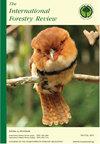Sustainable Forest Management and Forest Products Industry Development in Ethiopia
IF 0.9
4区 农林科学
Q2 FORESTRY
引用次数: 7
Abstract
HIGHLIGHTS Development and innovation in the sustainable forest products industry enhances socio-economic growth and the optimization of environmental objectives. Land and forest resources are the major basic productive factors for primary and secondary forest products manufacturing. Productive factors determine the development and competitiveness of forest products. Collective actions and inclusiveness are important in large-scale tree planting programmes for accelerated impact. A sustainable landscape approach is an effective tool for sustainable forest management and innovative forest products industry development. SUMMARY The objective of this study was to examine existing knowledge on forest products development and to promote sustainable forest management in Ethiopia. Furthermore, the paper aimed to assess the development and status of Ethiopia's forest products industry in terms of resource base, manufacturing and marketing. It was found that the current annual fuelwood consumption is about 133M m3, with 90% of cooking energy obtained from woody biomass. Wood consumption for primary and secondary forest products manufacturing is expected to increase from the current 112M m3 to 158M m3 by 2033. This review reveals that the development and innovation of a sustainable forest products industry in Ethiopia should balance the production and ecological functions of forest resources. To meet Ethiopia's primary and secondary forest products needs, it is recommended that a clear policy framework be advanced and promoted, including wood technology, forest science and education, silviculture, and post-plantation management practices.埃塞俄比亚可持续森林管理和林产品工业发展
亮点可持续林产品行业的发展和创新促进了社会经济增长和环境目标的优化。土地和森林资源是初级和次级林产品生产的主要基本生产要素。生产因素决定了森林产品的发展和竞争力。集体行动和包容性对于加快影响的大规模植树方案至关重要。可持续景观方法是可持续森林管理和创新林产品工业发展的有效工具。本研究的目的是检验埃塞俄比亚现有的森林产品开发知识,并促进埃塞俄比亚的可持续森林管理。此外,本文旨在评估埃塞俄比亚林产品工业在资源基础、制造和营销方面的发展和现状。研究发现,目前每年的薪材消耗量约为1.33亿立方米,其中90%的烹饪能源来自木质生物质。到2033年,用于初级和次生林产品制造的木材消耗量预计将从目前的1.12亿立方米增加到1.58亿立方米。这篇综述表明,埃塞俄比亚可持续林产品产业的发展和创新应平衡森林资源的生产和生态功能。为了满足埃塞俄比亚的初级和次级森林产品需求,建议推进和推广一个明确的政策框架,包括木材技术、森林科学和教育、造林和种植后管理实践。
本文章由计算机程序翻译,如有差异,请以英文原文为准。
求助全文
约1分钟内获得全文
求助全文
来源期刊

International Forestry Review
农林科学-林学
CiteScore
2.50
自引率
6.20%
发文量
29
审稿时长
>36 weeks
期刊介绍:
The International Forestry Review is a peer-reviewed scholarly journal that publishes original research and review papers on forest policy and science, with an emphasis on issues of transnational significance. It is published four times per year, in March, June, September and December. Special Issues are a regular feature and attract a wide audience. Click here for subscription details.
 求助内容:
求助内容: 应助结果提醒方式:
应助结果提醒方式:


